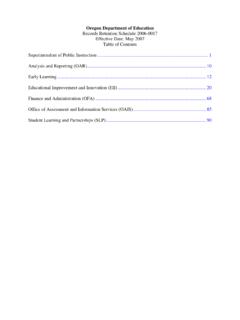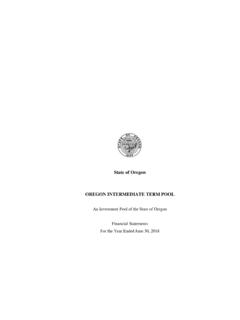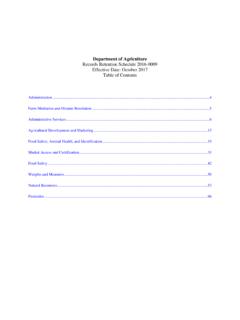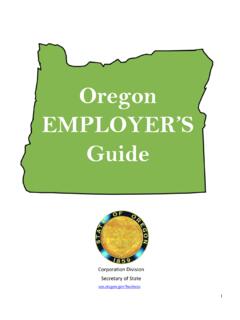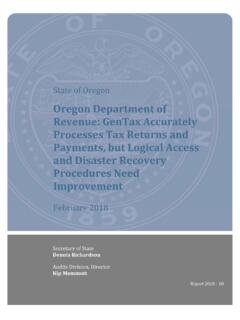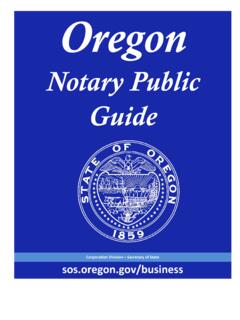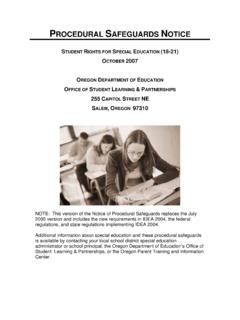Transcription of Department of Education Administrative ... - sos.oregon.gov
1 OFFICE OF THE SECRETARY OF STATE BILL BRADBURY SECRETARY OF STATE ARCHIVES DIVISION MARY BETH HERKERT DIRECTOR 800 Summer Street NE Salem, oregon 97310 (503) 373-0701 Facsimile (503) 378-4118 oregon Department of Education Administrative Overview April, 2007 Introduction The State of oregon 's public Education system consists of public school districts, community colleges, and Education service districts, with their own respective governing bodies. The oregon Legislature created the oregon State Board of Education to set the educational policies and standards of oregon s state schools and community colleges. Its mission is to consider the goals of modern Education , the requirements of a sound, comprehensive curriculum best suited to the needs of the students and the public and any other factors consistent with the maintenance of a modern and efficient elementary and secondary school system and community college program (ORS ).
2 In support of the board's mission, the oregon Department of Education provides policy and expertise in: The establishment of state standards for public kindergartens, elementary and secondary schools. Adopting rules for the general governance of public kindergartens, elementary and secondary schools. Prescribing the required or minimum course of study. Adopting rules regarding school and interscholastic activities. Adopting rules prohibiting discrimination in public schools (ORS ). In addition, the Department of Education manages the oregon School for the Blind, the oregon School for the Deaf and Education programs for adjudicated youth (ORS ).
3 The oregon State Department of Education functions under the control and operation of the oregon State Board of Education , with the Superintendent of Public Instruction serving as Administrative officer (ORS ). It is the responsibility of the oregon Department of Education to administer the educational policies and standards of the oregon State Board of Education . The Superintendent of Public Instruction serves as the chief facilitator of educational policy enacted by both law and the guidance of the State Board of Education (ORS ). 1 History The oregon State Constitution of 1859 established a system of common schools, and designated the governor as Superintendent of Public Instruction with the provision that after five years the Legislative Assembly would be allowed to create an independent office for this purpose (Const.)
4 , art. 8). The Legislative Assembly exercised this right in 1872 by enacting a law designating an elected four-year position, salary, and providing office space in the state capital ( 1872, p. 146). The 1872 law also created the State Board of Education . From 1872 to 1941 the board consisted of the Governor, the Secretary of State, and the Superintendent of Public Instruction. It was required to meet each January and July and was assigned the power to: Authorize the use of textbooks. Prescribe rules for schools. Sit as a Board of Examination to grant life diplomas and certificates to teachers. Grant diplomas and certificates without examination to people presenting authentic diplomas or certificates from other states.
5 Revoke any diploma or certificate for immoral or other unprofessional conduct ( 1872, p. 149). The superintendent also held additional duties to the overall mandate "to exercise a general superintendence of the county and district school officers and the public schools of the state ( 1872, p. 146). This included the requirement to annually visit public schools in every county statewide for the purpose of inspection, providing advice, and gathering statistics. If possible, they were also required to attend county teacher's institutes and assist in the organization and development of institute work in each county. Additionally, he was to visit the chartered higher Education institutions of the state to gather and verify statistical information to be presented to the Legislative Assembly.
6 ( 1899, p. 209-210) In order to assure proper and standard local administration of Education laws, the superintendent prepared and distributed a uniform series of blanks, business forms, and rules and regulations to county school officers. The superintendent also prepared informational circulars directed to school officers that dealt with topics such as school management and teacher responsibilities ( 1899, p. 209-210). Furthermore, the law authorized the superintendent to supply a list of required studies to be taught in public schools, to supervise the vote among county superintendents for the adoption of a standard series of textbooks, and to annotate and compile school laws ordered published by the Board of Education during his term of office ( 1872, p.)
7 147-148). In 1887 he was designated, in conjunction with the Board of Education , as the final arbiter of all questions and disputes concerning the interpretation of school laws ( 1887, p. 607). In 1899 the Legislative Assembly rewrote the school laws and gave additional duties and responsibilities to the superintendent. The new law created various boards and commissions to supervise programs and advise on special Education concerns. The new law required a state Board of Examiners to create questions for all state teacher certification tests, with the superintendent appointing members. The board filled this role until it was abolished in 1935 ( 1899, p.
8 209; 1935, ch. 38). Teachers were required to successfully complete an 2 examination for a specific teaching "class" and show evidence of good moral character. The superintendent exercised the power to grant and revoke certification and a 1911 law established a chain of appeal to the Board of Education ( 1911, ch. 58). During this time period, the superintendent became responsible for administering a mandated examination of 8th grade students. In 1905, the superintendent was made responsible for preparing examination questions; prescribing uniform rules for conducting examinations; and providing blank certificates of graduation to county superintendents ( 1905, ch.
9 75). In 1899, specialization in textbook selection became formalized with the creation of the state Board of Textbook Commissioners. From 1901 to 1927 this board was appointed by the governor and reported to the Board of Education . They chose textbooks to be used for six-year time periods ( 1899, p. 87). In 1927, the Board of Education began appointing members to the board ( 1927, ch. 321). Although in later years the board retained its quasi-independent status, its authority was limited in 1953 by the requirement to submit a multiple list of textbooks from which the Board of Education could choose ( 1953, ch. 121). The Legislative Assembly created the State Board for Vocational Education in 1919.
10 Growing interest in the field as well as federal funds provided by the National Vocational Education Act served as catalysts for this action. Members of this board consisted of the Board of Education (ex-officio) and four additional members appointed by the governor to represent agriculture, labor, employees, and "home interests." The board's responsibilities included cooperating with the federal government and distributing federal funds, administering oregon laws relating to vocational Education , formulating programs for integration into the public schools, certifying vocational Education teachers and institutions, and reporting biennially to the Legislative Assembly ( 1919, ch.)
